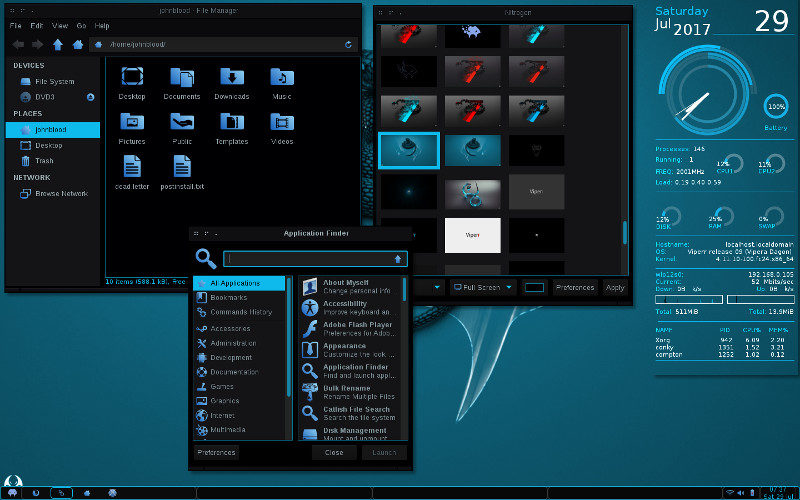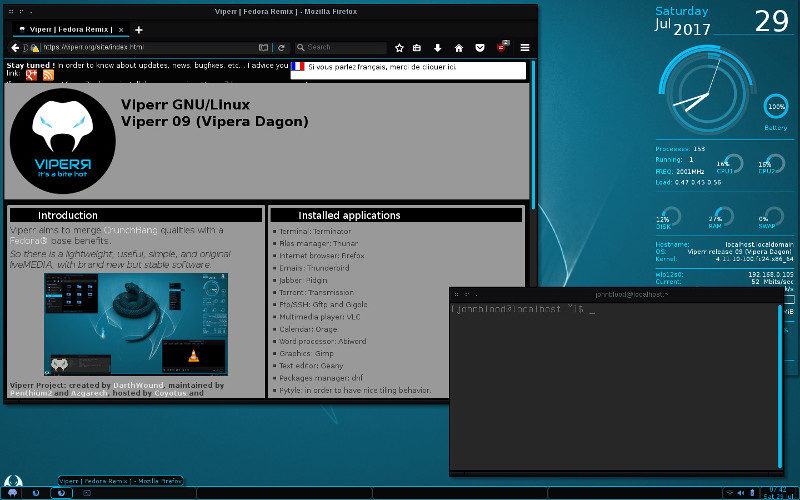
When I wrote ArchLabs review last month, a reader suggested me to try Viperr. ArchLabs is based on Arch Linux and Viperr is based on Fedora but both have similar missions and similar looks. They both try to keep CrunchBang alive, in one way or another.
My Bias against Fedora
I’d like to state right off the bat that I’m not a fan of Fedora. I’ve used both Fedora (24 and 25) and Korora (25). I usually ended up returning to Manjaro after a week or two. I was particularly frustrated by a glitch that appeared every time I logged into Korora. The screen would act as though the picture was scrambled for almost a minute before correcting itself. I was afraid that what was taking place would fail eventually and it would stay scrambled.
Then, last week things came to a head when I tried to test out the new Fedora 26. I experienced at least four crashes. Several of them happened after I tried to change the wallpaper and made the system inoperable. I know it wasn’t the ISO because I redownloaded it each time I installed it.
So, needless to say, I didn’t have high hopes for Viperr.
[irp posts=”15842″ name=”Antergos Review: It is More Than Just a Noob’s Arch Linux”]
Installation of Viperr Linux
I downloaded the Viperr ISO and used Etcher to put it on a USB drive. I booted into the live interface. It looked cool and my hopes were lifted.
The installer was the typically Anaconda installer that comes with Fedora. I was surprised that all the branding said Fedora instead of Viperr. After all, this was the 9th release of the distro. Surely, they figured out how to add their own branding by now.
After the install finished, I rebooted. Unlike booting into the live environment, this time the Viperr logo appeared and flashed as the system loaded. Once I logged in, I was greeted by a cool desktop and a post-install script. I was glad to see this little terminal window because I remembered it from CrunchBang, but it was missing in ArchLabs.
I was unable to run the script at first because I had not set up my wifi. I know I should have remembered to do this from the word go, but it would have been nice to have a reminder.
After I setup my wifi network, the script was able to work. It asked me if I wanted to install Viperr’s theme for Grub. Yes, let’s make this look cool. Did I want to replace Abiword with LibreOffice? Yes, I want to do some heavy duty work. Did I want to install numlockx? I didn’t have a number pad, so no. Did I need to use a print? Yes, at some point. Need to use Google Chrome? No, Firefox is fine. Install Flash plugin? Yes, some sites still need it. (At least until 2020.) Install the game crawl? Sure, I’ll give it a try. Install RPM Fusion free and nonfree repos? Yes, I want lots of software.
After it installed the programs needed based on my replied, it installed all the updates available.

Included Apps in Viperr
Here is a list of applications included in Viperr:
- Terminal: Terminator
- Files manager: Thunar
- Internet browser: Firefox
- Emails: Thunderbird
- Jabber: Pidgin
- Torrent: Transmission
- Ftp/SSH: Gftp and Gigolo
- Multimedia player: VLC
- Calendar: Orage
- Word processor: Abiword
- Graphics: Gimp
- Text editor: Geany
- Packages manager: dnf
- Pytyle: in order to have nice tiling behavior.
- Appfinder: lists all the installed apps.
It also has some useful tools for Openbox and other tasks.

[irp posts=”15881″ name=”Kali Linux Review: Not Everyone’s Cup of Tea”]
Final Thoughts on Viperr Linux
Overall, I liked the look and feel of Viperr. For some reason, it felt better than all the times I had tried Fedora in the past. It felt very clean and very fast. Once I learned a couple terminal commands, I was off and running. I think I’ll add Viperr to my list of favorite distros, along with Solus, Manjaro, and ArchLabs.
However, even though I had a great experience, there were a couple small niggles. First of all, Viperr is based on Fedora 24. That means that the underpinnings of the most recent release of Viperr are based on software that was released in June of 2016. In order to get Viperr up-to-date, I had to install 581 updates. That’s a lot when you consider that people use Fedora usually do so to be on the bleeding edge. Also, the projects Google+ page hasn’t seen an update in 16 weeks, almost 4 months.
The third problem I ran into was that everything seemed small. The icons in the system tray were unreadable. The font in the terminal was very small, making it very hard to run commands. This is something that I can change, but I would be nice if the devs had thought of it.
So, in conclusion, Viperr has a couple problem spots, but in the long run, I would run it over Fedora.
Have you ever used Viperr? What is your favorite minimal Linux distro? Please let us know in the comments below.
If you found this article interesting, please take a minute to share it on social media.

